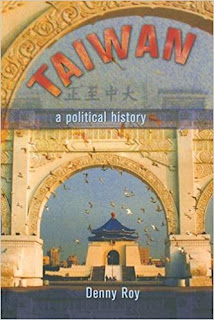I'm trying to read more books about Taiwan, alternating between fiction and non-fiction. Denny Roy’s history is the latest one I've completed.
I’ve lived in Taiwan for a decade. I already knew the broad outlines of this land’s history. But this was the first time I read a survey of Taiwan’s post-1945 political history. I figured it was time I learned more, and indeed I did learn a lot from Roy’s book. Now, the book is not for the novice with no preexisting knowledge of Taiwanese history. Denny Roy tends to move back and forth through the decades, expecting his reader to already know the political progression from the elder Chiang to the younger Chiang to Lee to Chen. But if you’re moderately familiar with the basics, this is an informative look at Taiwanese politics from 1945 to 2003, when the book was published.
I write “from 1945 to 2003” even though the book is billed as covering the full scope of Taiwanese history. In reality, everything prior to 1895 is covered in twenty pages. The fifty years of Japanese rule, 1895 to 1945, receive another twenty-two pages. The remainder of the book’s 246 pages are devoted to the ROC era. This is fine -- there is certainly a lot to say about Taiwan under the ROC, and the starting chapters do provide necessary historical context for what comes after -- but the reader should be aware that this is not a comprehensive source of material about Taiwan before 1945.
In fact, I was a bit frustrated with the coverage of early Taiwanese history. On page 21, Roy writes of “a total of 159 sizable rebellions during the period of Qing rule, including three particularly large ‘Great Rebellions’ in 1714, 1787, and 1833”. He then goes on to describe an uprising in 1721 in which rebels seized control of a large portion of Taiwan, forcing the government to flee to mainland China. If this doesn’t qualify as a ‘Great Rebellion’, some truly epic uprisings must have been cut for space! On page 22 two rebellions are briefly described as taking place in 1786 and 1832; Roy never mentions one that happens anytime close to 1714.
Fortunately, Roy’s coverage of the 1945 to 2003 era is interesting and informative, and filled in several gaps in my knowledge of Taiwanese political history, about which I do not claim to be an expert.
To take one example, I noted a recurring theme where the ROC’s stubbornness decades ago contributed to the country’s present-day international status. It was the ROC that took Taiwan out of the United Nations: even when Chiang Kai-shek came to accept a PRC presence in the UN, he couldn’t bear the indignity of the PRC taking his place on the Security Council, and so Taiwan quit in a huff when the PRC was admitted in 1971. (p. 134-135) Similarly, there was a time when Beijing would enter into full diplomatic relations with countries that recognized Taipei, without demanding that these nations break relations with them. They didn’t need to -- Taipei would be so angered at the perceived disrespect that they would be the ones to sever ties with one more diplomatic ally. (p. 130) Well done, ROC -- that’s worked out well for you, hasn’t it? I can only conclude that ROC leaders must have been perpetually convinced that the PRC was on the brink of implosion -- not an entirely illogical belief, when you consider what the PRC must have looked like to them for the first quarter-century of its existence, staggering from one massive self-inflicted crisis to another.
To take another example, I knew Lee Teng-hui primarily for his more recent role as an elder statesman and a pro-independence figure who has decisively burned his ties with the KMT, so reading about how he was perceived when he was actually the head of the KMT was fascinating. In contrast to the impression I had of Lee in his retirement, Roy paints quite a different portrait of Lee as cunning politician - summarized on page 181 that “Lee’s desire to consolidate his power took precedence over his ideological commitment to political liberalization”. The book’s 2003 publication date means that there’s a time capsule-like quality to how certain figures are portrayed, notably the well-known anti-corruption crusader Ma Ying-jeou. Even Tsai Ing-wen makes a cameo on page 237 where she pops up in the year 2000 to clarify that Taiwan doesn’t accept Beijing’s One-China Principle.
Overall, as a relatively brief overview of Taiwanese history, Roy’s book gave me what I was looking for: I learned a lot, and several shameful gaps in my knowledge were plugged. There are still several books on Taiwanese politics sitting unread on my bookshelf, which I can read now with a better knowledge base to build on.

No comments:
Post a Comment